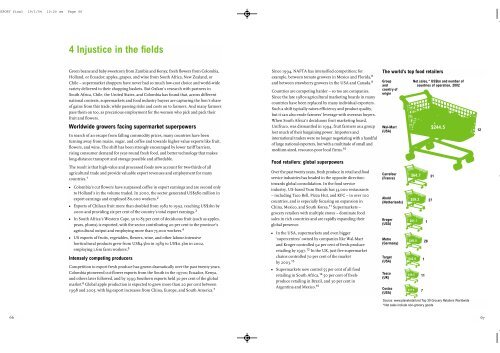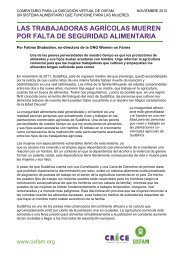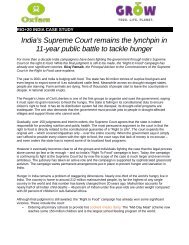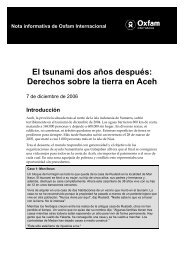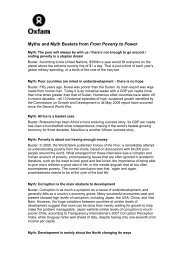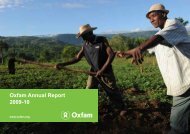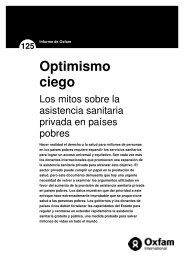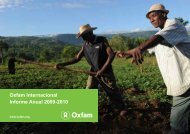Trading Away Our Rights - Oxfam International
Trading Away Our Rights - Oxfam International
Trading Away Our Rights - Oxfam International
You also want an ePaper? Increase the reach of your titles
YUMPU automatically turns print PDFs into web optimized ePapers that Google loves.
EPORT final 19/1/04 10:20 am Page 664 Injustice in the fieldsGreen beans and baby sweetcorn from Zambia and Kenya; fresh flowers from Colombia,Holland, or Ecuador; apples, grapes, and wine from South Africa, New Zealand, orChile – supermarket shoppers have never had so much low-cost choice and world-widevariety delivered to their shopping baskets. But <strong>Oxfam</strong>’s research with partners inSouth Africa, Chile, the United States, and Colombia has found that, across differentnational contexts, supermarkets and food industry buyers are capturing the lion’s shareof gains from this trade, while passing risks and costs on to farmers. And many farmerspass them on too, as precarious employment for the women who pick and pack theirfruit and flowers.Worldwide growers facing supermarket superpowersIn search of an escape from falling commodity prices, many countries have beenturning away from maize, sugar, and coffee and towards higher-value exports like fruit,flowers, and wine. The shift has been strongly encouraged by lower tariff barriers,rising consumer demand for year-round fresh food, and better technology that makeslong-distance transport and storage possible and affordable.The result is that high-value and processed foods now account for two-thirds of allagricultural trade and provide valuable export revenues and employment for manycountries. 1• Colombia’s cut flowers have surpassed coffee in export earnings and are second onlyto Holland’s in the volume traded. In 2000, the sector generated US$580 million inexport earnings and employed 80,000 workers. 2• Exports of Chilean fruit more than doubled from 1982 to 1992, reaching US$1bn by2000 and providing six per cent of the country’s total export earnings. 3• In South Africa’s Western Cape, 50 to 85 per cent of deciduous fruit (such as apples,pears, plums) is exported, with the sector contributing 20 per cent to the province’sagricultural output and employing more than 75,000 workers. 4• US exports of fruits, vegetables, flowers, wine, and other labour-intensivehorticultural products grew from US$4.5bn in 1989 to US$11.3bn in 2002,employing 1.6m farm workers. 5Intensely competing producersCompetition to export fresh produce has grown dramatically over the past twenty years.Colombia pioneered cut-flower exports from the South in the 1970s; Ecuador, Kenya,and others later followed, and by 1999 Southern exports held 30 per cent of the globalmarket. 6 Global apple production is expected to grow more than 20 per cent between1998 and 2005, with big export increases from China, Europe, and South America. 7Since 1994, NAFTA has intensified competition; forexample, between tomato growers in Mexico and Florida, 8and between strawberry growers in the USA and Canada. 9Groupandcountry oforiginNet sales,* US$bn and number ofcountries of operation, 2002Countries are competing harder – so too are companies.Since the late 1980s agricultural marketing boards in manycountries have been replaced by many individual exporters.Such a shift typically raises efficiency and product quality,but it can also erode farmers’ leverage with overseas buyers.When South Africa’s deciduous fruit marketing board,Unifruco, was dismantled in 1994, fruit farmers as a group Wal-Mart$244.5lost much of their bargaining power. Importers and(USA)international traders were no longer negotiating with a handfulof large national exporters, but with a multitude of small andmedium-sized, resource-poor local firms. 10Food retailers: global superpowersOver the past twenty years, fresh produce in retail and foodservice industries has headed in the opposite direction:towards global consolidation. In the food serviceindustry, US-based Yum Brands has 33,000 restaurants– including Taco Bell, Pizza Hut, and KFC – in over 100countries, and is especially focusing on expansion inChina, Mexico, and South Korea. 11 Supermarkets –grocery retailers with multiple stores – dominate foodsales in rich countries and are rapidly expanding theirglobal presence.• In the USA, supermarkets and even bigger‘supercentres’ owned by companies like Wal-Martand Kroger controlled 92 per cent of fresh-produceretailing by 1997. 12 In the UK, just five supermarketchains controlled 70 per cent of the marketby 2003. 13• Supermarkets now control 55 per cent of all foodretailing in South Africa, 14 50 per cent of freshproduceretailing in Brazil, and 30 per cent inArgentina and Mexico. 15The world’s top food retailersCarrefour(France)Ahold(Netherlands)Kroger(USA)Metro(Germany)Target(USA)Tesco(UK)Costco(USA)$64.7$59.2$51.7$48.5$43.9$39.5$37.91117128Source: www.planetretail.net Top 30 Grocery Retailers Worldwide*Net sales include non-grocery goods3127126667


